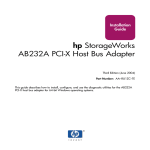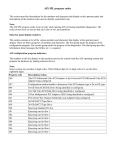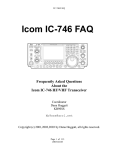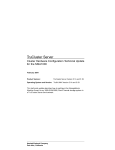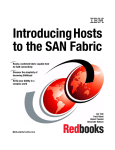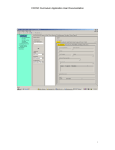Download HP AB232A Installation Guide
Transcript
installation guide hp StorageWorks fca2384 PCI-X host bus adapter for OpenVMS and Tru64 UNIX installation guide First Edition (April 2003) Part Number: AA-RTJYA-TE This guide describes how to install, configure, and troubleshoot the HP StorageWorks FCA2384 PCI-X host bus adapter for Tru64 UNIX and OpenVMS operating systems. © Hewlett-Packard Company, 2003. All rights reserved. Hewlett-Packard Company makes no warranty of any kind with regard to this material, including, but not limited to, the implied warranties of merchantability and fitness for a particular purpose. Hewlett-Packard shall not be liable for errors contained herein or for incidental or consequential damages in connection with the furnishing, performance, or use of this material. This document contains proprietary information, which is protected by copyright. No part of this document may be photocopied, reproduced, or translated into another language without the prior written consent of Hewlett-Packard. The information contained in this document is subject to change without notice. Intel® is a U.S. registered trademark of Intel Corporation. UNIX® is a registered trademark of The Open Group. Hewlett-Packard Company shall not be liable for technical or editorial errors or omissions contained herein. The information is provided “as is” without warranty of any kind and is subject to change without notice. The warranties for Hewlett-Packard Company products are set forth in the express limited warranty statements accompanying such products. Nothing herein should be construed as constituting an additional warranty. Printed in the U.S.A. FCA2384 PCI-X Host Bus Adapter for OpenVMS and Tru64 UNIX Installation Guide First Edition (April 2003) Part Number: AA-RTJYA-TE contents Contents About this Guide Overview. . . . . . . . . . . . . . . . . . . . . . . . . . . . . . . . . . . . . . . . . . . . . . . . . . . . . . . . . . . . . . . . . . 6 Intended Audience . . . . . . . . . . . . . . . . . . . . . . . . . . . . . . . . . . . . . . . . . . . . . . . . . . . . . . . 6 Related Documentation . . . . . . . . . . . . . . . . . . . . . . . . . . . . . . . . . . . . . . . . . . . . . . . . . . . 6 Conventions . . . . . . . . . . . . . . . . . . . . . . . . . . . . . . . . . . . . . . . . . . . . . . . . . . . . . . . . . . . . . . . 7 Document Conventions . . . . . . . . . . . . . . . . . . . . . . . . . . . . . . . . . . . . . . . . . . . . . . . . . . . 7 Text Symbols . . . . . . . . . . . . . . . . . . . . . . . . . . . . . . . . . . . . . . . . . . . . . . . . . . . . . . . . . . . 7 Equipment Symbols . . . . . . . . . . . . . . . . . . . . . . . . . . . . . . . . . . . . . . . . . . . . . . . . . . . . . . 8 Rack Stability . . . . . . . . . . . . . . . . . . . . . . . . . . . . . . . . . . . . . . . . . . . . . . . . . . . . . . . . . . . . . 10 Getting Help . . . . . . . . . . . . . . . . . . . . . . . . . . . . . . . . . . . . . . . . . . . . . . . . . . . . . . . . . . . . . . 11 HP Technical Support . . . . . . . . . . . . . . . . . . . . . . . . . . . . . . . . . . . . . . . . . . . . . . . . . . . 11 HP Storage Website . . . . . . . . . . . . . . . . . . . . . . . . . . . . . . . . . . . . . . . . . . . . . . . . . . . . . 11 HP Authorized Reseller . . . . . . . . . . . . . . . . . . . . . . . . . . . . . . . . . . . . . . . . . . . . . . . . . . 12 1 2 3 Introduction Product Description . . . . . . . . . . . . . . . . . . . . . . . . . . . . . . . . . . . . . . . . . . . . . . . . . . . . . . . . Performance Specifications . . . . . . . . . . . . . . . . . . . . . . . . . . . . . . . . . . . . . . . . . . . . . . . . . . Standards. . . . . . . . . . . . . . . . . . . . . . . . . . . . . . . . . . . . . . . . . . . . . . . . . . . . . . . . . . . . . . . . . Agency Approvals . . . . . . . . . . . . . . . . . . . . . . . . . . . . . . . . . . . . . . . . . . . . . . . . . . . . . . . . . 14 16 17 18 Installation Prerequisites . . . . . . . . . . . . . . . . . . . . . . . . . . . . . . . . . . . . . . . . . . . . . . . . . . . . . . . . . . . . . . Hardware Requirements. . . . . . . . . . . . . . . . . . . . . . . . . . . . . . . . . . . . . . . . . . . . . . . . . . Set Jumpers . . . . . . . . . . . . . . . . . . . . . . . . . . . . . . . . . . . . . . . . . . . . . . . . . . . . . . . . . . . Recording Reference Numbers. . . . . . . . . . . . . . . . . . . . . . . . . . . . . . . . . . . . . . . . . . . . . . . . Installing the HBA into a Computer. . . . . . . . . . . . . . . . . . . . . . . . . . . . . . . . . . . . . . . . . . . . Verifying the Installation . . . . . . . . . . . . . . . . . . . . . . . . . . . . . . . . . . . . . . . . . . . . . . . . . . . . Configuration Guidelines . . . . . . . . . . . . . . . . . . . . . . . . . . . . . . . . . . . . . . . . . . . . . . . . . . . . 20 20 20 21 22 24 24 Installing and Configuring Device Drivers Tru64 UNIX Driver and Alpha Console Support. . . . . . . . . . . . . . . . . . . . . . . . . . . . . . . . . . 26 FCA2384 PCI-X Host Bus Adapter for OpenVMS and Tru64 UNIX Installation Guide 3 Contents Using the Alpha Console wwidmgr -show adapter and -set adapter Commands. . . . . . . . . . . . . . . . . . . . . . . . . . . . . . . . . . . . . . . . . . . . . . . . . . . . . . Using the wwidmgr -show adapter Command. . . . . . . . . . . . . . . . . . . . . . . . . . . . . . . . . Using the wwidmgr -set adapter Command. . . . . . . . . . . . . . . . . . . . . . . . . . . . . . . . . . . OpenVMS Driver and Console Support . . . . . . . . . . . . . . . . . . . . . . . . . . . . . . . . . . . . . . . . . 4 Troubleshooting Power-On Self Test (POST) . . . . . . . . . . . . . . . . . . . . . . . . . . . . . . . . . . . . . . . . . . . . . . . . . . 31 A Regulatory Compliance Notices FCC Compliance Information Statement . . . . . . . . . . . . . . . . . . . . . . . . . . . . . . . . . . . . . . . . Japanese Notice . . . . . . . . . . . . . . . . . . . . . . . . . . . . . . . . . . . . . . . . . . . . . . . . . . . . . . . . Canadian Notice . . . . . . . . . . . . . . . . . . . . . . . . . . . . . . . . . . . . . . . . . . . . . . . . . . . . . . . . Avis Canadien . . . . . . . . . . . . . . . . . . . . . . . . . . . . . . . . . . . . . . . . . . . . . . . . . . . . . . Federal Communications Commission Notice . . . . . . . . . . . . . . . . . . . . . . . . . . . . . . . . . . . . Japanese Notice . . . . . . . . . . . . . . . . . . . . . . . . . . . . . . . . . . . . . . . . . . . . . . . . . . . . . . . . Canadian Notice . . . . . . . . . . . . . . . . . . . . . . . . . . . . . . . . . . . . . . . . . . . . . . . . . . . . . . . . Avis Canadien . . . . . . . . . . . . . . . . . . . . . . . . . . . . . . . . . . . . . . . . . . . . . . . . . . . . . . B 27 28 29 30 33 34 34 34 35 35 36 36 Electrostatic Discharge Grounding Methods . . . . . . . . . . . . . . . . . . . . . . . . . . . . . . . . . . . . . . . . . . . . . . . . . . . . . . . . 38 Glossary Index Figures 1 FCA2384 Host Bus Adapter . . . . . . . . . . . . . . . . . . . . . . . . . . . . . . . . . . . . . . . . . . . 14 Tables 1 2 3 4 5 6 4 Document Conventions . . . . . . . . . . . . . . . . . . . . . . . . . . . . . . . . . . . . . . . . . . . . . . . . 7 Host Bus Adapter Diagram Description . . . . . . . . . . . . . . . . . . . . . . . . . . . . . . . . . . 15 HBA Voltage and Minimum PCI Slot Requirements . . . . . . . . . . . . . . . . . . . . . . . . 20 Jumper Settings . . . . . . . . . . . . . . . . . . . . . . . . . . . . . . . . . . . . . . . . . . . . . . . . . . . . . 20 Normal POST LED Indicator . . . . . . . . . . . . . . . . . . . . . . . . . . . . . . . . . . . . . . . . . . 24 POST LED States . . . . . . . . . . . . . . . . . . . . . . . . . . . . . . . . . . . . . . . . . . . . . . . . . . . 33 FCA2384 PCI-X Host Bus Adapter for OpenVMS and Tru64 UNIX Installation Guide about this guide About this Guide This installation guide provides information to help you: ■ Install, configure, and About troubleshoot this Guide the FCA2384 PCI-X host bus adapter (HBA) for Tru64 UNIX and OpenVMS operating systems. ■ Contact technical support for additional assistance About this Guide topics include: ■ Overview, page 6 ■ Conventions, page 7 ■ Rack Stability, page 10 ■ Getting Help, page 11 FCA2384 PCI-X Host Bus Adapter for OpenVMS and Tru64 UNIX Installation Guide 5 About this Guide Overview This section covers the following topics: ■ Intended Audience ■ Related Documentation Intended Audience This book is intended for use by administrators who are experienced with the following: ■ Tru64 UNIX and OpenVMS operating systems ■ Host bus adapters Related Documentation In addition to this guide, HP provides release notes. 6 FCA2384 PCI-X Host Bus Adapter for OpenVMS and Tru64 UNIX Installation Guide About this Guide Conventions Conventions consist of the following: ■ Document Conventions ■ Text Symbols ■ Equipment Symbols Document Conventions The document conventions included in Table 1 apply in most cases. Table 1: Document Conventions Element Convention Cross-reference links Blue text: Figure 1 Key and field names, menu items, buttons, and dialog box titles Bold File names, application names, and text emphasis Italics User input, command and directory names, and system responses (output and messages) Monospace font COMMAND NAMES are uppercase monospace font unless they are case sensitive Variables <monospace, italic font> Website addresses Blue, underlined sans serif font text: http://www.hp.com Text Symbols The following symbols may be found in the text of this guide. They have the following meanings. WARNING: Text set off in this manner indicates that failure to follow directions in the warning could result in bodily harm or loss of life. FCA2384 PCI-X Host Bus Adapter for OpenVMS and Tru64 UNIX Installation Guide 7 About this Guide Caution: Text set off in this manner indicates that failure to follow directions could result in damage to equipment or data. Note: Text set off in this manner presents commentary, sidelights, or interesting points of information. Equipment Symbols The following equipment symbols may be found on hardware for which this guide pertains. They have the following meanings. Any enclosed surface or area of the equipment marked with these symbols indicates the presence of electrical shock hazards. Enclosed area contains no operator serviceable parts. WARNING: To reduce the risk of injury from electrical shock hazards, do not open this enclosure. Any RJ-45 receptacle marked with these symbols indicates a network interface connection. WARNING: To reduce the risk of electrical shock, fire, or damage to the equipment, do not plug telephone or telecommunications connectors into this receptacle. Any surface or area of the equipment marked with these symbols indicates the presence of a hot surface or hot component. Contact with this surface could result in injury. WARNING: To reduce the risk of injury from a hot component, allow the surface to cool before touching. 8 FCA2384 PCI-X Host Bus Adapter for OpenVMS and Tru64 UNIX Installation Guide About this Guide Power supplies or systems marked with these symbols indicate the presence of multiple sources of power. WARNING: To reduce the risk of injury from electrical shock, remove all power cords to completely disconnect power from the power supplies and systems. Any product or assembly marked with these symbols indicates that the component exceeds the recommended weight for one individual to handle safely. WARNING: To reduce the risk of personal injury or damage to the equipment, observe local occupational health and safety requirements and guidelines for manually handling material. FCA2384 PCI-X Host Bus Adapter for OpenVMS and Tru64 UNIX Installation Guide 9 About this Guide Rack Stability Rack stability protects personal and equipment. WARNING: To reduce the risk of personal injury or damage to the equipment, be sure that: ■ The leveling jacks are extended to the floor. ■ The full weight of the rack rests on the leveling jacks. ■ In single rack installations, the stabilizing feet are attached to the rack. ■ In multiple rack installations, the racks are coupled. ■ Only one rack component is extended at any time. A rack may become unstable if more than one rack component is extended for any reason. 10 FCA2384 PCI-X Host Bus Adapter for OpenVMS and Tru64 UNIX Installation Guide About this Guide Getting Help If you still have a question after reading this guide, contact an HP authorized service provider or access our website: http://www.hp.com. HP Technical Support In North America, call technical support at 1-800-652-6672, available 24 hours a day, 7 days a week. Note: For continuous quality improvement, calls may be recorded or monitored. Outside North America, call technical support at the nearest location. Telephone numbers for worldwide technical support are listed on the HP website under support: http://www.hp.com/country/us/eng/support.html. Be sure to have the following information available before calling: ■ Technical support registration number (if applicable) ■ Product serial numbers ■ Product model names and numbers ■ Applicable error messages ■ Operating system type and revision level ■ Detailed, specific questions HP Storage Website The HP website has the latest information on this product, as well as the latest drivers. Access storage at: http://www.hp.com/country/us/eng/prodserv/ storage.html. From this website, select the appropriate product or solution. FCA2384 PCI-X Host Bus Adapter for OpenVMS and Tru64 UNIX Installation Guide 11 About this Guide HP Authorized Reseller For the name of your nearest HP authorized reseller: 12 ■ In the United States, call 1-800-345-1518 ■ In Canada, call 1-800-263-5868 ■ Elsewhere, see the HP website for locations and telephone numbers: http://www.hp.com. FCA2384 PCI-X Host Bus Adapter for OpenVMS and Tru64 UNIX Installation Guide Introduction 1 This introduction to the FCA2384 Host Bus Adapter (HBA) includes: ■ Product Description ■ Table 2 describes the HBA components. ■ Standards ■ Agency Approvals FCA2384 PCI-X Host Bus Adapter for OpenVMS and Tru64 UNIX Installation Guide 13 Introduction Product Description The HBA has the following characteristics: ■ Small form factor (SFF) interface and Lucent Connector (LC) Fibre connector. ■ Embedded optical short-wave laser, multi-mode Fibre Channel interface. ■ Designed using a single custom Application Specific Integrated Circuit (ASIC). The custom ASIC implements a very high performance, multi-class, multi-protocol Fibre Channel host adapter with a 64-bit PCI-X bus connection. ■ 66/100/133MHz PCI-X 1.0a, PCI 2.2, and PCI 2.1 compatibility. ■ 266MIPs onboard processor, an embedded 1GB/2GB Serializer/Deserializer (SERDES), and a high performance unified Quadrennial Defense Review Static RAM (QDR SRAM). ■ Controlled by a 266 MHz, 32-bit Intel Strong Acorn Risc Machine (StrongARM) RISC processor. Figure 1 shows the FCA2384 HBA. 1 2 Figure 1: FCA2384 Host Bus Adapter 14 FCA2384 PCI-X Host Bus Adapter for OpenVMS and Tru64 UNIX Installation Guide Introduction Table 2 describes the HBA components. Table 2: Host Bus Adapter Diagram Description Figure Legend Description 1 POST LED Indicators Note: See Table 5 and Table 6 for detailed descriptions. 2 Fibre Channel (LC) connectors. FCA2384 PCI-X Host Bus Adapter for OpenVMS and Tru64 UNIX Installation Guide 15 Introduction Performance Specifications The FCA2384 PCI-X host bus adapter offers a highly integrated 2Gb/s Fibre Channel HBA for use in servers based on either PCI or the latest PCI-X expansion bus. The features of this PCI-X based HBA provide the flexibility and broad interoperability needed for complex, highly scalable SANs. The FCA2384 also features sophisticated hardware that provides superior performance in SANs and provides best in class server CPU off load. This exclusive hardware delivers low latency and high throughput in switched fabric, arbitrated loop, and clustered environments. Support for fiber optic cabling is provided through an embedded small form factor (LC) optical interface. The FCA2384 is both ANSI Fibre Channel and PCI Local Bus Compliant and supports: ■ Simultaneous full duplex 2 Gbps PCI bus speed data transfers of 400 MBps ■ Full fabric support using F_PORT and FL_Port connections ■ Onboard hardware context cache for superior fabric performance ■ FC-Tape (FC-2) devices ■ Point-to-point arbitrated-loop, and switch fabric FC connections ■ Storage protocol ■ Fibre Channel class 2 and 3 ■ Automatic speed negotiation and topology detection ■ End-to-end parity protection for high data integrity ■ Buffered data architecture to support over 50km cabling at full 2Gb/s bandwidth Collectively, these characteristics create a high-performance Fibre Channel HBA. 16 FCA2384 PCI-X Host Bus Adapter for OpenVMS and Tru64 UNIX Installation Guide Introduction Standards The HBA conforms to the following standards: ■ ANSI Fibre Channel FC-PH, Revision 4.3 ■ ANSI Fibre Channel FC-AL, Revision 4.5 ■ ANSI Fibre Channel FC-FS ■ ANSI Fibre Channel FC-PI ■ ANSI Fibre Channel FC-PLDA ■ ANSI Fibre Channel FC-MI ■ ANSI Fibre Channel FC-FLA ■ Fibre Channel Class 2, 3 ■ PCI-X 1.0a ■ PCI local bus revision 2.2 ■ PHP hot plug - hot swap FCA2384 PCI-X Host Bus Adapter for OpenVMS and Tru64 UNIX Installation Guide 17 Introduction Agency Approvals The HBA has the following agency approvals: 18 ■ CFR Title 21, Laser AEL Class 1, FDA/CDRH ■ UL recognized to UL1950 ■ CUR recognized to CSA22.2, No.950 ■ EN68025-1 (1994) + Amendment 11 ■ EN68025-2 (1994) ■ TUV certified to EN60950 ■ FCC Rules, CFR Title 47, Part 15, Subpart B, Class A ■ Industry Canada, ICES-003, Class A ■ EN55022 (1998)/CISPR22 (1997) Class A ■ EN55024 (1998) ■ CE-Marking Directive 93/68/EEC (CE Mark) ■ EMC Directive 89/336/EEC (as amended by 92/31/EEC) ■ Australian EMC Framework (C-Tick Mark) ■ AS/NZS 3548:1995, Class A ■ VCCI, Class A FCA2384 PCI-X Host Bus Adapter for OpenVMS and Tru64 UNIX Installation Guide Installation 2 This chapter provides step-by-step instructions for installing the FCA2384 host bus adapter (HBA) including: ■ Prerequisites ■ Recording Reference Numbers ■ Installing the HBA into a Computer ■ Verifying the Installation ■ Configuration Guidelines This chapter also provides information on installation guidelines and supported configurations for the operating systems. Note: The HBA contains static-sensitive components. Comply with Electrostatic Discharge (ESD) procedures. FCA2384 PCI-X Host Bus Adapter for OpenVMS and Tru64 UNIX Installation Guide 19 Installation Prerequisites The following prerequisites are provided to help you install the FCA2384 HBA. Hardware Requirements Table 3 describes the voltage and minimum PCI slot requirements for the FCA2384. Table 3: HBA Voltage and Minimum PCI Slot Requirements HBA Voltage Requirement 3.3 VDC HBA PCI Signaling Voltage 3.3 volt, 5 volt Tolerant PCI Slot Type Universal PCI connector In addition, you must use Multimode fiber optic cable with LC connector, used with short-wave lasers. Set Jumpers Table 4 lists the FCA2384 jumper settings. The HBA has two jumper blocks (JX1, JX2) that control the host adapter's device ID. The default device ID is F980. Table 4: Jumper Settings Device ID 20 Jumper Setting F980 JX1:1-2, JX2:2-3 1AE5 JX1:2-3, JX2:2-3 F981 JX1:2-3, JX2:1-2 FCA2384 PCI-X Host Bus Adapter for OpenVMS and Tru64 UNIX Installation Guide Installation Recording Reference Numbers Each HBA ships with a unique address identifier that is stored in flash memory. Fibre Channel industry standards issue two unique identifiers: WorldWide Port Name (WWPN) and Node Name (NN), each of which is derived from the HBA’s IEEE address. Combined, the WWPN and NN create the WorldWide Name (WWN) which is an 8-byte field that uniquely identifies an HBA on a FC circuit. The WWN address and serial number are clearly marked on the HBA. Record the addresses on the lines below for future reference. IEEE address: __________________________________________________ Serial number: __________________________________________________ FCA2384 PCI-X Host Bus Adapter for OpenVMS and Tru64 UNIX Installation Guide 21 Installation Installing the HBA into a Computer Following is the procedure for installing the HBA into a computer. WARNING: Be sure to observe the ESD precautions for this procedure. 1. Make sure the computer is powered off. 2. Remove the screws on the computer cover, and then remove the cover. 3. Wearing a static wrist strap, remove the blank panel from an empty 32- or 64-bit PCI or PCI-X bus slot. Compare the removed panel to the bracket on the host bus adapter. Follow steps 4-7 to change the bracket if they are different sizes. Note: The host bus adapter comes with a standard PCI bracket installed. The low-profile mounting bracket is shorter than the standard bracket; approximately 3.11 in. (7.9cm) compared to 4.75 in. (12.06 cm) long. 4. Remove the mounting bracket screws from the top of the host bus adapter. 5. Remove the bracket and store it for future use. 6. Using the bracket on the HBA, align the new mounting bracket tabs with the holes in the HBA. Note: Be careful not to push the bracket past the transceiver housing's grounding tabs. 7. Replace the screws that attach the HBA to the bracket. 8. Insert the HBA into the empty PCI or PCI-X bus slot; press firmly until it is seated securely. 9. Secure the HBA mounting bracket to the computer panel with the panel screws. 10. Replace the computer cover and secure it using the previously removed screws. 22 FCA2384 PCI-X Host Bus Adapter for OpenVMS and Tru64 UNIX Installation Guide Installation 11. Attach media: a. Connect the fiber optic cable to the LC connector on the HBA. b. Connect the other end of the cable to the Fibre Channel device. Note: The HBA does not allow normal data transmission on an optical link unless it is connected to a similar or compatible laser product. That is, both products are multimode to multimode. FCA2384 PCI-X Host Bus Adapter for OpenVMS and Tru64 UNIX Installation Guide 23 Installation Verifying the Installation To verify the HBA is properly installed and is operating: 1. Turn on the computer. 2. At power up, observe the POST LED indicators on the HBA. The position of the POST LED indicators is defined in Figure 1 and Table 4 of this guide. The green LED indicates power functions and the amber LED signifies port activity. The amber LED blinks at all times during normal operation. Table 5 lists normal indications. Table 5: Normal POST LED Indicator Amber LED (L1) Green LED (L2) State Flashing (irregular) Off POST processing in progress Slow blink (1 Hz) On Normal—1 Gb link rate Fast blink (4 Hz) On Normal—2 Gb link rate Off Blink (1 Hz) Normal—link down or not yet started Configuration Guidelines The software for loading the driver also contains the default registry parameter settings that are loaded as part of the driver installation. Consult the following sources for any restriction and for information on supported configurations specific to your operating system and topology. 24 ■ Release Notes ■ HP Website at: http://www.hp.com/country/us/eng/support.html. FCA2384 PCI-X Host Bus Adapter for OpenVMS and Tru64 UNIX Installation Guide Installing and Configuring Device Drivers 3 This chapter describes how to install and configure the Host Bus Adapter (HBA) device drivers. It includes the following sections: ■ Tru64 UNIX Driver and Alpha Console Support ■ Using the Alpha Console wwidmgr -show adapter and -set adapter Commands ■ OpenVMS Driver and Console Support You should be familiar with the operating system under which the HBA operates. You must also have access to standard operating system documentation. The HBA software kit contains the latest version of the HBA files at the time of shipment. You can obtain periodic updates from the HP website: http://www.hp.com/country/us/eng/prodserv/storage.html. Note: HP recommends that you back up all operating system files before you install and configure the HBA device drivers. FCA2384 PCI-X Host Bus Adapter for OpenVMS and Tru64 UNIX Installation Guide 25 Installing and Configuring Device Drivers Tru64 UNIX Driver and Alpha Console Support This HBA driver is built into the Tru64 UNIX operating system and is supported by the Alpha Console. For the supported versions of Tru64 UNIX and the Alpha Console, consult the HBA Release Notes included in this documentation package. Release notes are updated periodically and can be obtained from the HP website: http://www.hp.com/country/us/eng/prodserv/storage.html. Drill down through Services and Support to Adapter Support. See the documentation specific to your platform for detailed information on installing the appropriate operating system and Alpha Console. Note: You must initialize the Console before and after issuing wwidmgr commands. Otherwise, the server will not reboot. 26 FCA2384 PCI-X Host Bus Adapter for OpenVMS and Tru64 UNIX Installation Guide Installing and Configuring Device Drivers Using the Alpha Console wwidmgr -show adapter and -set adapter Commands With Alpha Console V6.4 and higher, you can set the HBA to run in either Fiber Channel Arbitrated Loop (FC-AL) mode or in Fabric (Switch) mode. By default, the console assumes a fabric topology. When configuring the HBA, keep the following considerations in mind: ■ You must set the Console to diagnostic mode using the set mode diag command to use wwidmgr -show adapter and the -set adapter commands. ■ The wwidmgr -set adapter command stores the selected topology into the NVRAM storage on the HBA. If you move the HBA from one Alpha Server to another, this setting stays with the HBA. Alpha Console V6.4 and higher is required to support the FC-AL loop topology. ■ An FC-AL loop setting is a valid setting in Alpha Console V6.4, however, that setting prompts the console driver not to run. Caution: If you connect an HBA to a switch using an FC-AL loop setting, the results are unpredictable. The same is true for setting an HBA in fabric mode. Access the wwidmgr manual as follows for detailed information on the wwidmgr -show adapter and -set adapter commands: 1. Browse to ftp://ftp.digital.com/pub/DEC/Alpha/firmware/. 2. Select the directory for the current console firmware release. 3. Select the doc directory. 4. Select wwidmgr.pdf. The following section describes how to use these commands to view and set the HBA driver configuration. FCA2384 PCI-X Host Bus Adapter for OpenVMS and Tru64 UNIX Installation Guide 27 Installing and Configuring Device Drivers Using the wwidmgr -show adapter Command Use the wwidmgr -show adapter command to view HBA configuration. The following example shows a display from wwidmgr -show adapter for a system with two HBAs: The following table describes the elements of the following display line in detail: [0]kgpsaa0.0.0.4.6 Item 28 1000-0000-c921-05ab Description fabric fabric Explanation [0] Item Number A parameter to the –item qualifier in the -set adapter command. You can select which HBA to configure by its item number. An item number of 9999 selects all HBAs. kgpsaa0.0.0.4.6 Adapter Mnemonic Error messages and displays use this identifier. 1000-0000-c921-05ab The HBA’s WWN This value identifies the HBA to other nodes on the fibre channel link. fabric Current Topology The HBA’s operating mode for the current session; either fabric or loop. This mode is not affected during a wwidmgr session. fabric Next Topology The topology setting for the HBA’s NVRAM. Unavail indicates that the NVRAM is not formatted. Fabric or loop indicates the HBA’s configuration the next time the system is initialized. FCA2384 PCI-X Host Bus Adapter for OpenVMS and Tru64 UNIX Installation Guide Installing and Configuring Device Drivers Using the wwidmgr -set adapter Command Use the wwidmgr -set adapter command to format the HBA NVRAM and to configure an HBA to run on a loop or a fabric. The command format is: wwidmgr -set adapter -item<itemno> -topo<fabric I loop> The itemno bracketed value is the value from the –show adapter command. You can change all HBAs from fabric to loop by specifying an itemno value of 9999. In the following example, init is placed at the end to emphasize that the setting in the running HBA is not changed until the next initialization. FCA2384 PCI-X Host Bus Adapter for OpenVMS and Tru64 UNIX Installation Guide 29 Installing and Configuring Device Drivers OpenVMS Driver and Console Support The HBA driver is built into the OpenVMS operating system, into the TIMA Kit. The HBA is supported by the Alpha Console. You configure the driver using the Console for your version of OpenVMS. See the documentation specific to your platform for detailed information on installing the appropriate operating system, Console software, and for upgrading the firmware. For the supported versions of OpenVMS, TIMA Kit, and Console, see the HBA Release Notes included in this documentation package. Release notes are updated periodically and can be obtained from the HP website: http://www.hp.com/country/us/eng/prodserv/storage.html. Drill down through Services and Support to Adapter Support. 30 FCA2384 PCI-X Host Bus Adapter for OpenVMS and Tru64 UNIX Installation Guide 4 Troubleshooting Power-On Self Test (POST) The Power-On Self Test (POST) is a troubleshooting utility that you can use for the FCA2384 host bus adapter (HBA). This chapter explains the use of this utility in the event of an HBA problem. Table 6 lists the HBA LED states with descriptions of each state.The position of the POST LED indicators is defined in Figure 1 and Table 2 of this guide. If the LEDs indicate a failure during POST: 1. Make sure that the HBA is seated firmly in the PCI slot. 2. Verify that the fibre cable connection to the HBA is secure. Table 6: POST LED States Amber LED (L1) Green LED (L2) Description Off Off Wake-up failure (dead board) On Off POST failure (dead board) Slow blink (1 Hz) Off Wake-up failure (dead board) Fast blink (4 Hz) Off Failure in POST (dead board) Flashing (irregular) Off POST processing in progress Off On Failure while functioning On On Failure while functioning Slow blink (1 Hz) On Normal—1 Gb link rate Fast blink (4 Hz) On Normal—2 Gb link rate Off Blink (1 Hz) Normal—link down or not yet started FCA2384 PCI-X Host Bus Adapter for OpenVMS and Tru64 UNIX Installation Guide 31 Troubleshooting 32 FCA2384 PCI-X Host Bus Adapter for OpenVMS and Tru64 UNIX Installation Guide Regulatory Compliance Notices A FCC Compliance Information Statement This device complies with Part 15 of the FCC Rules. Operation is subject to the following two conditions: (1) This device may not cause harmful interference, and (2) this device must accept any interference received, including interference that may cause undesired operation. This equipment has been tested and found to comply with the limits for a Class A digital device, pursuant to part 15 of the FCC Rules. These limits are designed to provide reasonable protection against harmful interference when the equipment is operated in a commercial environment. This equipment generates, uses, and can radiate radio frequency energy and, if not installed and used in accordance with the instruction manual, may cause harmful interference to radio communications. Operation of this equipment in a residential area is likely to cause harmful interference in which case the user will be required to correct the interference at his own expense. Shielded cables must be used between this equipment and attached peripheral devices. The reader is cautioned that changes or modifications made to the equipment not expressly approved could void the user's authority to operate this equipment. For questions regarding your product, contact: Hewlett-Packard Company 3000 Hanover St. Palo Alto, CA 94304-1185 Or call 1-800-652-6672. To identify the device, refer to the part, series or model number found on the product. The above statement applies to products marketed in the USA. FCA2384 PCI-X Host Bus Adapter for OpenVMS and Tru64 UNIX Installation Guide 33 Regulatory Compliance Notices Japanese Notice Canadian Notice This Class A digital apparatus meets all requirements of the Canadian Interference-Causing Equipment Regulations. Avis Canadien Cet appareil numérique de la classe A respecte toutes les exigences du Règlement sur le matériel brouilleur du Canada. 34 FCA2384 PCI-X Host Bus Adapter for OpenVMS and Tru64 UNIX Installation Guide Regulatory Compliance Notices Federal Communications Commission Notice This equipment has been tested and found to comply with the limits for a Class A digital device, pursuant to Part 15 of the FCC rules. These limits are designed to provide reasonable protection against harmful interference in a residential installation. Any modifications to this device - unless expressly approved by the manufacturer - can void the user’s authority to operate this equipment under part 15 of the FCC rules. Operation is subject to the following two conditions: (1) This device may not cause harmful interference and (2) This device must accept any interference that may cause undesirable operation. This equipment generates, uses, and can radiate radio frequency energy and, if not installed and used in accordance with the instructions, may cause harmful interference to radio communications. However, there is no guarantee that interference will not occur in a particular installation. If this equipment does cause harmful interference to radio or television reception, which can be determined by turning the equipment off and on, the user is encouraged to try to correct the interference by one or more of the following measures: ■ Reorient or relocate the receiving antenna. ■ Increase the separation between the equipment and receiver. ■ Connect the equipment into an outlet on a circuit different from that to which the receiver is connected. ■ Consult the dealer or an experienced radio/TV technician for help. Japanese Notice FCA2384 PCI-X Host Bus Adapter for OpenVMS and Tru64 UNIX Installation Guide 35 Regulatory Compliance Notices Canadian Notice This Class A digital apparatus meets all requirements of the Canadian Interference-Causing Equipment Regulations. Avis Canadien Cet appareil numérique de la classe A respecte toutes les exigences du Règlement sur le matériel brouilleur du Canada. 36 FCA2384 PCI-X Host Bus Adapter for OpenVMS and Tru64 UNIX Installation Guide Electrostatic Discharge B To prevent damaging the system, be aware of the precautions you need to follow when setting up the system or handling parts. A discharge of static electricity from a finger or other conductor may damage system boards or other static-sensitive devices. This type of damage may reduce the life expectancy of the device. To prevent electrostatic damage, observe the following precautions: ■ Avoid hand contact by transporting and storing products in static-safe containers. ■ Keep electrostatic-sensitive parts in their containers until they arrive at static-free workstations. ■ Place parts on a grounded surface before removing them from their containers. ■ Avoid touching pins, leads, or circuitry. ■ Always make sure you are properly grounded when touching a static-sensitive component or assembly. FCA2384 PCI-X Host Bus Adapter for OpenVMS and Tru64 UNIX Installation Guide 37 Electrostatic Discharge Grounding Methods There are several methods for grounding. Use one or more of the following methods when handling or installing electrostatic-sensitive parts: ■ Use a wrist strap connected by a ground cord to a grounded workstation or computer chassis. Wrist straps are flexible straps with a minimum of 1 megohm ± 10 percent resistance in the ground cords. To provide proper grounding, wear the strap snug against the skin. ■ Use heel straps, toe straps, or boot straps at standing workstations. Wear the straps on both feet when standing on conductive floors or dissipating floor mats. ■ Use conductive field service tools. ■ Use a portable field service kit with a folding static-dissipating work mat. If you do not have any of the suggested equipment for proper grounding, have a HP authorized reseller install the part. Note: For more information on static electricity, or for assistance with product installation, contact your HP authorized reseller. 38 FCA2384 PCI-X Host Bus Adapter for OpenVMS and Tru64 UNIX Installation Guide glossary Glossary This glossary defines terms used in this guide or related to this product and is not a comprehensive glossary of computer terms. Glossary AL-PA Arbitrated Loop Physical Address. The address of a Fibre Channel node in an arbitrated loop. Arbitration The process of selecting one respondent from a collection of several candidates that request service at the same time. b/s (or bps) Bits per second. The number of energy pulses passing a given point in a transmission medium in one second; raw transmission speed before encoding. Bandwidth A measure of the information-carrying capacity of an optical fiber, normalized to a unit of MHz/km. This term is used to specify capacity of multi-mode fibers only. (For single-mode fibers, use dispersion). The difference between the highest and lowest frequencies in a specific range of frequencies. Baud A unit of signaling speed equal to the number of signal intervals per second, which might or might not be equal to the data rate in bits per second. The encoded bit rate per second. BIOS Basic Input/Output system. Software coded into the computer chips to accomplish various tasks. Boot BIOS Software coded into the chips on the HBA. A special program used to boot and control the computer. FCA2384 PCI-X Host Bus Adapter for OpenVMS and Tru64 UNIX Installation Guide 39 Glossary Broadband In data transmission, it denotes transmission facilities capable of handling frequencies greater than those required for high-grade voice communications. The higher frequency allows the carrying of several simultaneous channels. Cladding The dielectric material surrounding the core of an electrical fiber or material surrounding the core of a fiber optic cable. It usually refers to diameter, often 125 m, measured in microns. Connector A mechanical device used to align and join two fibers together to provide a means for attaching and decoupling it to a transmitter, receiver, or another fiber. Core The central region of an optical fiber through which light is transmitted. Custom Device Module (CDM) A CDM is the driver component in the NetWare Peripheral Architecture used to drive specific storage devices attached to the HBA. See also NetWare Peripheral Architecture. Data Rate The maximum number of bits of information that can be transmitted per second in a data transmission link. It is typically expressed as Megabits per second (Mbps). Device Driver A software program that enables a personal computer to communicate with hard drives, CD-ROM drives, printers, and other peripherals. Device drivers are stored on a hard drive and are loaded into memory at boot up. Duplex Cable A two-fiber cable suitable for duplex transmission or transmissions in two directions. Duplex Transmission Transmission in both directions, either one direction at a time (half duplex) or both directions simultaneously (full duplex). Fabric A Fibre Channel interconnection method that allows multiple simultaneous and concurrent data transfers between multiple hosts and/or storage devices connected with a multi-port hub. FC-AL Abbreviation for Fibre Channel Arbitrated Loop, an interconnection scheme that supports from 1 to 126 ports on a loop in a shared medium topology. 40 FCA2384 PCI-X Host Bus Adapter for OpenVMS and Tru64 UNIX Installation Guide Glossary FCP Fibre Channel Protocol. FDDI Fibre Distributed Data Interface. A network based on the use of optical-fiber cable to transmit data at 100Mbit/sec. Fiber Thin filament of glass. An optical waveguide consisting of a core and cladding, which is capable of carrying information in the form of light. Fibre is also a general term used to cover all physical media types supported by Fibre Channel, such as optical fiber, twisted pair, and coaxial cable. Fiber Optics Light transmission through optical fibers for communication or signaling. Fibre Channel A high-speed, serial, bidirectional, topology independent, multi-protocol, highly scalable interconnection between computers, peripherals, and networks. Gb/s Gigabits per second or 1 billion bits per second. A reference to processing speed. GB/s Gigabytes per second or 1,073,741,824 bytes per second. A reference to processing speed. GLM Gigabit Link Module. A transmitter and receiver that provides high-speed serial links, enabling continuous throughput in each direction simultaneously. Host Adapter Module (HAM) A HAM is the driver component used to drive specific HBA hardware in the NetWare Peripheral Architecture (NPA). Interrupt Request (IRQ) Network boards are supplied with default settings for the IRQ, I/O port and base memory address. An IRQ is a signal protocol used by hardware devices, such as printers and modems, to let the computer know that they need some attention. When an IRQ is invoked, the CPU puts its other work “on hold” and services the needs of the interrupting device. Kilometer 1,000 meters or 3,281 feet. The kilometer is a unit of measurement commonly used in fiber optics. To convert kilometers to miles, multiply the number of kilometers by .62 to achieve the number of miles. To convert miles to kilometers, multiply the number of miles by 1.61 to achieve the number in kilometers. FCA2384 PCI-X Host Bus Adapter for OpenVMS and Tru64 UNIX Installation Guide 41 Glossary Laser Light Amplification by Stimulated Emission of Radiation. A device that produces coherent light with a narrow range of wavelengths. Latency Delay in transmission; can be caused by arbitration time prior to winning control of the network. Light In the laser and optical communication fields, the portion of the electromagnetic spectrum that can be handled by the basic optical techniques used for the visible spectrum extending from the near ultraviolet region of approximately 0.3 micron, through the visible region, and into the mid-infrared region of about 30 microns. Light Emitting Diode (LED) A device used in a transmitter to convert information from electrical to optical form. It typically has a large spectral width. Lightwaves Electromagnetic waves in the region of optical frequencies. The term “light” was originally restricted to radiation visible to the human eye, with wavelengths between 400 and 700 nanometers (nm). However, it has become customary to refer to radiation in the spectral regions adjacent to visible light (in the near infrared from 700 to about 2000 nm) as “light” to emphasize the physical and technical characteristics. Link A fiber optic cable with connectors attached to a transmitter (source) and receiver (detector). Longwave Refers to length of the wave or frequency in the spectrum of light. 780 nm is the operating range of short wave lasers, while 1300 nm describes the range of long wave lasers. LUN Logical Unit Number. A three-bit identifier for a Logical Unit. The maximum number of LUNs per SCSI target is 8, numbered LUN0 through LUN7. Mb/s Megabits per second or 1,000 bits per second. A reference to processing speed. MB/s Megabytes per second or 1,000 bytes per second. A reference to processing speed. 42 FCA2384 PCI-X Host Bus Adapter for OpenVMS and Tru64 UNIX Installation Guide Glossary Media Manager (MM) A database built into NetWare that keeps track of all peripheral storage devices and media attached to NetWare servers, and allows applications to gain access and get information. The Media Manager receives application I/O requests and converts them to messages compatible with the NPA architecture. Micron (mm) Another term for micrometer. One millionth of a meter. 10-6 meter. Mode A term used to describe a light path through a fiber, as in multi-mode or single-mode. Multi-initiators Two different Fibre Channel HBAs in one arbitrated loop sharing the same storage devices, but not communicating with each other. Multi-Mode Fiber An optical waveguide in which light travels in multiple modes. Typical core/cladding sizes (measured in microns) are 50/125, 62.5/125, and 100/140. Multiplexing The process by which two or more signals are transmitted over a single communications channel. NetWare Peripheral Architecture (NWPA) Network architecture that provides a broader and more reliable driver support for third-party host adapters and storage devices. The NPWA separates NetWare driver support into two components: a Host Adapter Module (HAM), and a Custom Device Module (CDM). See also Custom Device Module and Host Adapter Module. nm Nanometer. A unit of measurement equal to one billionth of a meter. 10-9 meter. Non-OFC Non-Open Fiber Control. GLMs that do not contain OFC control but still guarantee laser emission levels to be below Class 1. OFC Open Fiber Control. A power monitoring/control system which continuously monitors the optical fiber link between two ports and prevents any laser emission from exceeding Class 1 levels in the event of a break anywhere in the path. FCA2384 PCI-X Host Bus Adapter for OpenVMS and Tru64 UNIX Installation Guide 43 Glossary Optical Waveguide Dielectric waveguide with a core consisting of optically transparent material or low attenuation (usually silica glass) and with cladding consisting of optically transparent material of lower refractive index than that of the core. It is used for the transmission of signals with lightwaves and is frequently referred to as fiber. PCI Bus # An internal Peripheral Connect Interface bus number in a computer. PCI Bus # is set by the computer system’s BIOS, and in most cases, the number is zero. PCI Device # PCI slot number in a computer. Point-To-Point (PTP) A connection established between two specific locations, as between two buildings. Protocol A data transmission convention encompassing timing, control, formatting, and data representation. SCSI Small Computer Systems Interface. SelectID Used to configure Seagate drives. A matrix for relating ALPA (hex) numbers to SelectID (hex) numbers. Shortwave Refers to length of the wave or frequency in the spectrum of light. 780 nm is the operating range of short wave lasers, while 1300nm describes the range of long wave lasers. Simplex Cable A term sometimes used for a single-fiber cable. Simplex Transmission Transmission in one direction only. Single-Mode Fiber An optical waveguide (or fiber) with a small core diameter in which only a single mode is capable of propagation. This type of fiber is particularly suitable for wideband transmission over large distances, since its bandwidth is limited only by chromatic dispersion. Topology The logical and/or physical arrangement of stations on a network. 44 FCA2384 PCI-X Host Bus Adapter for OpenVMS and Tru64 UNIX Installation Guide Glossary Transducer A device for converting energy from one form to another, such as optical energy to electrical energy. ULP Upper Level Protocol. Waveguide Structure that guides electromagnetic waves along its length. An optical fiber is an optical waveguide. Wavelength The distance between two crests of an electromagnetic waveform. FCA2384 PCI-X Host Bus Adapter for OpenVMS and Tru64 UNIX Installation Guide 45 Glossary 46 FCA2384 PCI-X Host Bus Adapter for OpenVMS and Tru64 UNIX Installation Guide index A G agency approvals 18 Alpha console OpenVMS 30 Tru64 UNIX 27 audience 6 authorized reseller, HP 12 getting help 11 H D device drivers OpenVMS 30 Tru64 UNIX 26 document conventions 7 related documentation 6 E electrostatic discharge 37 equipment symbols 8 F FCA2284 host bus adapter See HBAs FCC Compliance notice 33 Federal Communications Commission notice 35 Index configuration guidelines for HBAs 24 conventions document 7 equipment symbols 8 text symbols 7 Index C HBAs agency approvals 18 configuration guidelines 24 installation overview 19 installation procedure 22 normal POST LED indicators 24 POST LED results 31 product description 13 recording reference numbers 21 standards 17 verifying installation 24 help, obtaining 11 HP authorized reseller 12 storage website 11 technical support 11 I installation HBA overview 19 HBAs 22 verifying HBA installation 24 O OpenVMS Alpha console 30 device drivers 30 FCA2384 PCI-X Host Bus Adapter for OpenVMS and Tru64 UNIX Installation Guide 47 Index P T POST LED indicators troubleshooting 31 verifying HBA installation 24 technical support, HP 11 text symbols 7 troubleshooting, using POST LED results 31 Tru64 UNIX Alpha console 27 Tru64 UNIX device drivers 26 R rack stability, warning 10 reference numbers 21 regulatory compliance notices FCC Compliance 33 Federal Communications Commission 35 related documentation 6 S -set adapter command 29 -show adapter command 28 standards, for HBAs 17 symbols in text 7 symbols on equipment 8 48 W warning rack stability 10 symbols on equipment 8 websites HP storage 11 wwidmgr -set adapter command 29 -show adapter command 28 FCA2384 PCI-X Host Bus Adapter for OpenVMS and Tru64 UNIX Installation Guide



















































